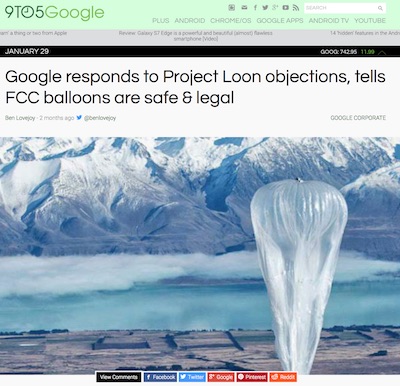 The Federal Communications Commission on March 17 gave Google permission to float high-altitude balloons that provide Wi-Fi in 50 states. Anti-Wi-Fi groups say they are dangerous but Google denies all such charges.
The Federal Communications Commission on March 17 gave Google permission to float high-altitude balloons that provide Wi-Fi in 50 states. Anti-Wi-Fi groups say they are dangerous but Google denies all such charges.
"The proposed (Project Loon) experimental operations in fact present vastly less risk from radio frequency exposure than other transmissions the Commission routinely authorizes,” Google told the FCC.
Google said it respects the concerns of the critics but says “there is no factual basis for them.” Loon will comply with all existing technical rules governing radio transmissions, and the power levels used will be well below legal limits, said Google. It has taken “extensive steps” to guard against interference with other wireless activity.
The company plans to conduct tests in all 50 states for a period of two years. A Loon balloon landed in Sri Lanka Feb. 17, 2016. The company said it had completed its test mission.
GUARDS Fights Project Loon
Global Union Against Radiation Deployment from Space says it gave FCC evidence that the Loon experiments in the U.S. would “violate human rights and harm human health and the environment.”
The company’s application to the FCC gives it permission to float the balloons at any time or continuously. That will “pollute public and private environments indoors and outdoors with microwave radiation” and does not include any requirement to tell people in the area who will be so exposed, GUARDS said.
"Loon uses both ground-level and balloon-borne RF-generating equipment designed to encourage proliferation of RF radiation reiiant wireless communication systems, particularly in areas formerly without radiation saturation,” says GUARDS.
FCC’s RF limits are based on the premise that if there is no heating damage to human flesh there are no biological effects, the group says. It quotes the 2012 BioInitiative Report that says the duration of exposure of non-ionizing radiation can cause harm to human tissues.”


 Lo Isidro, senior director at Real Chemistry with more than a decade of strategic communications and PA experience, has joined Narrative Strategies.
Lo Isidro, senior director at Real Chemistry with more than a decade of strategic communications and PA experience, has joined Narrative Strategies. Nelson Fernandez, former North American chair of APCO Worldwide and managing director of Burson-Marsteller, has joined Volunteers in Medicine Berkshires as director of communications and PA.
Nelson Fernandez, former North American chair of APCO Worldwide and managing director of Burson-Marsteller, has joined Volunteers in Medicine Berkshires as director of communications and PA. Lilit Bargar, who was most recently an EVP in the healthcare practice at Weber Shandwick, comes on board at GCI Health as EVP, corporate practice lead.
Lilit Bargar, who was most recently an EVP in the healthcare practice at Weber Shandwick, comes on board at GCI Health as EVP, corporate practice lead.
 Five ways that successful thought leaders are made.
Five ways that successful thought leaders are made.


 Have a comment? Send it to
Have a comment? Send it to 
No comments have been submitted for this story yet.